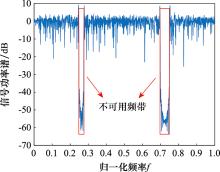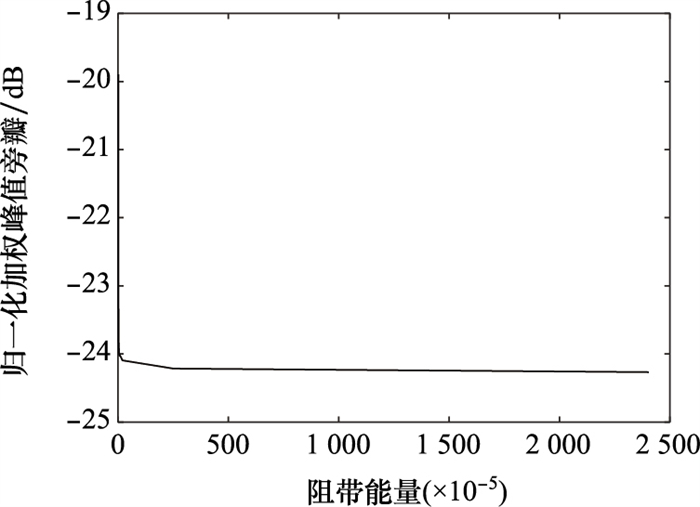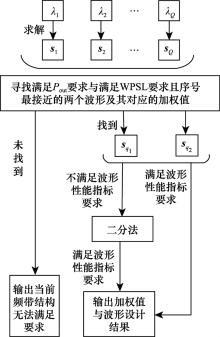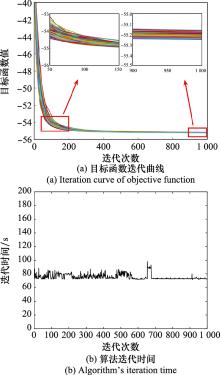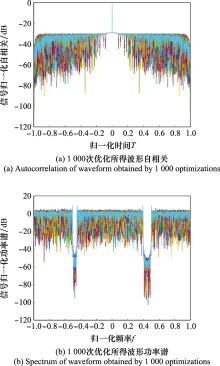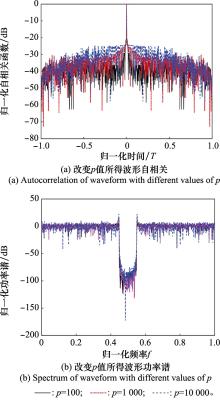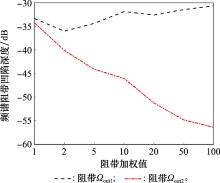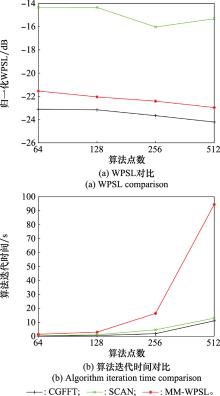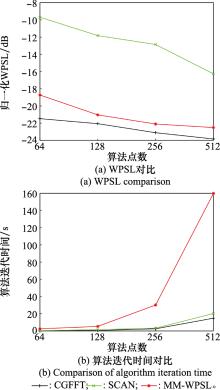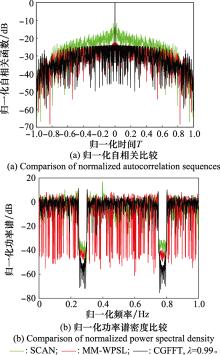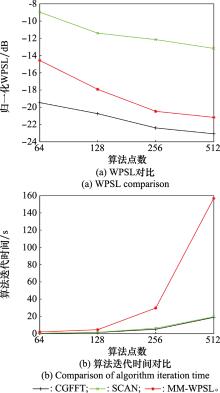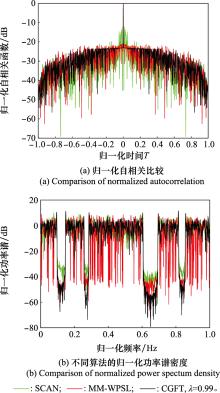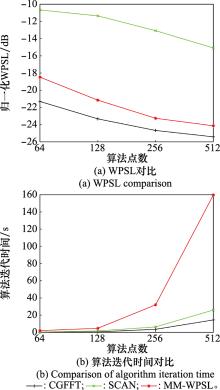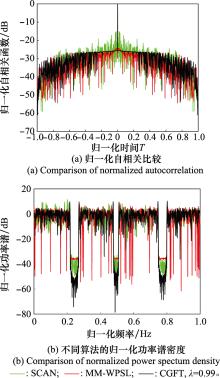Systems Engineering and Electronics ›› 2025, Vol. 47 ›› Issue (4): 1036-1047.doi: 10.12305/j.issn.1001-506X.2025.04.02
• Electronic Technology • Previous Articles Next Articles
Fast optimization method for multi-criteria joint spectrally compatible waveform
Zhaobo JIA1,2, Lei YU1,2,*, Yinsheng WEI1,2
- 1. School of Electronics and Information Engineering, Harbin Institute of Technology, Harbin 150001, China
2. Key Laboratory of Marine Environmental Monitoring and Information Processing, Ministry of Industry and Information Technology, Harbin 150001, China
-
Received:2024-04-01Online:2025-04-25Published:2025-05-28 -
Contact:Lei YU
CLC Number:
Cite this article
Zhaobo JIA, Lei YU, Yinsheng WEI. Fast optimization method for multi-criteria joint spectrally compatible waveform[J]. Systems Engineering and Electronics, 2025, 47(4): 1036-1047.
share this article
| 1 |
BU Y , QIU H , FAN T , et al. Constant modulus sequence set design with low weighted integrated sidelobe level in spectrally crowded environments[J]. Science China: Information Sciences, 2022, 65 (5): 159303.
doi: 10.1007/s11432-020-3249-1 |
| 2 | 位寅生, 徐朝阳. 非连续谱雷达信号设计综述[J]. 雷达学报, 2022, 11 (2): 183- 197. |
| WEI Y S , XU Z Y . Review of signal design for discontinuous spectrum radar[J]. Journal of Radars, 2022, 11 (2): 183- 197. | |
| 3 |
ZHANG Y , WEI Y S , YU L . Anti-jamming pulse diversity phase coded waveform design based on periodic ambiguity function shaping[J]. Signal Processing, 2022, 196, 108510.
doi: 10.1016/j.sigpro.2022.108510 |
| 4 | WEI Y S, JIA Z B, XU Z Y. SINR and WPSL performance analysis for frequency sparse waveform[C]//Proc. of the IEEE International Radar Conference, 2023. |
| 5 | SALZMAN J, AKAMINE D, LEFEVRE R. Optimal waveforms and processing for sparse frequency UWB operation[C]//Proc. of the IEEE Radar Conference, 2001: 105-110. |
| 6 |
ZHANG Y , WEI Y S , YU L . ISRJ rejection with MIMO radar using space-time complex modulation in multi-jamming scenario[J]. IEEE Trans. on Aerospace and Electronic Systems, 2023, 59 (6): 8725- 8742.
doi: 10.1109/TAES.2023.3308485 |
| 7 | 姚誉, 李泽清, 范文, 等. 基于ABSUM的MIMO雷达频谱兼容波形设计[J]. 雷达学报, 2022, 11 (4): 543- 556. |
| YAO Y , LI Z Q , FAN W , et al. Spectrally compatible waveform design for MIMO radar based on ABSUM method[J]. Journal of Radars, 2022, 11 (4): 543- 556. | |
| 8 |
AUBRY A , CAROTENUTO V , DE M A , et al. Optimization theory-based radar waveform design for spectrally dense environments[J]. IEEE Aerospace and Electronic Systems Magazine, 2016, 31 (12): 14- 25.
doi: 10.1109/MAES.2016.150216 |
| 9 | TANG B , LIANG J L . Efficient algorithms for synthesizing probing waveforms with desired spectral shapes[J]. IEEE Trans. on Aerospace and Electronic Systems, 2018, 55 (3): 1174- 1189. |
| 10 | XU Z Y, WEI Y S. Waveform design of sparse frequency with limited ISL performance[C]//Proc. of the 6th International Conference on Imaging, Signal Processing and Communications, 2022: 77-81. |
| 11 | MAO Z N , WEI Y S . Interpulse-frequency-agile and intrapulse-phase-coded waveform optimisation for extend-range correlation sidelobe suppression[J]. IET Radar, Sonar & Navigation, 2017, 11 (10): 1530- 1539. |
| 12 |
QUAN J H , ZHANG A L , XU P , et al. Radar and communication spectral sharing under multiple spectral compatibility constraints[J]. IEEE Wireless Communications Letters, 2022, 11 (10): 2120- 2124.
doi: 10.1109/LWC.2022.3194353 |
| 13 | 王鑫海, 王超宇, 张宁, 等. 一种相位域低积分旁瓣雷达波形优化方法[J]. 雷达学报, 2022, 11 (2): 255- 263. |
| WANG X H , WANG C Y , ZHANG N , et al. Phase-only method for designing a unimodular radar waveform with low ISL[J]. Journal of Radars, 2022, 11 (2): 255- 263. | |
| 14 |
WEI W Y , WEI Y S , YU L . MIMO waveforms design with good correlation properties under bound constraints[J]. Signal Processing, 2023, 212, 109168.
doi: 10.1016/j.sigpro.2023.109168 |
| 15 | ZHAO D H , WEI Y S , LIU Y T . Hopped-frequency waveform design for range sidelobe suppression in spectral congestion[J]. IET Radar, Sonar & Navigation, 2018, 12 (1): 87- 94. |
| 16 |
LINDENFELD M J . Sparse frequency transmit-and-receive waveform design[J]. IEEE Trans. on Aerospace and Electronic Systems, 2004, 40 (3): 851- 861.
doi: 10.1109/TAES.2004.1337459 |
| 17 |
LIANG J L , SO H C , LI J , et al. Unimodular sequence design based on alternating direction method of multipliers[J]. IEEE Trans. on Signal Processing, 2016, 64 (20): 5367- 5381.
doi: 10.1109/TSP.2016.2597123 |
| 18 | GREEN S D, KINGSLEY S P. Improving the range/time sidelobes of large bandwidth discontinuous spectra HF radar waveforms[C]//Proc. of the 7th International Conference on HF Radio Systems and Techniques, 1997: 246-250. |
| 19 | WEI Y S, LIU Y T. New anti-jamming waveform designing and processing for HF radar[C]//Proc. of the CIE International Conference on Radar Proceedings, 2001: 281-284. |
| 20 | ARASU K T, CLARK M R, MCMANUS T M. A new class of optimal frequency hopping sequences with applications to secure communication waveforms[C]//Proc. of the 33rd International Telecommunication Networks and Applications Conference, 2023: 19-24. |
| 21 |
AUBRY A , CAROTENUTO V , DE M A . Forcing multiple spectral compatibility constraints in radar waveforms[J]. IEEE Signal Processing Letters, 2016, 23 (4): 483- 487.
doi: 10.1109/LSP.2016.2532739 |
| 22 | SHI S N , WANG Z Y , HE Z S , et al. Spectrally compatible waveform design for MIMO radar with ISL and PAPR constraints[J]. IEEE Sensors Journal, 2019, 20 (5): 2368- 2377. |
| 23 |
ZHAO D H , WEI Y S , LIU Y T . PCFM radar waveform design with spectral and correlation considerations[J]. IEEE Trans. on Aerospace and Electronic Systems, 2017, 53 (6): 2885- 2898.
doi: 10.1109/TAES.2017.2719359 |
| 24 | WANG Y H , WANG W , DENG Y K , et al. A 2D method based on nonlinear frequency modulation waveform and phase coding for range ambiguity suppression[J]. IEEE Geoscience and Remote Sensing Letters, 2023, 20, 4001205. |
| 25 | HE H, STOICA P, LI J. Waveform design with stopband and correlation constraints for cognitive radar[C]//Proc. of the 2nd International Workshop on Cognitive Information Processing, 2010: 344-349. |
| 26 |
SHENTU X Y , LAI X P , WANG T L , et al. Efficient ADMM-based algorithm for regularized minimax approximation[J]. IEEE Signal Processing Letters, 2023, 30, 210- 214.
doi: 10.1109/LSP.2023.3253053 |
| 27 | ZENG S M, LI Y Z, TAO R. Two-dimensional transmit beam pattern design via majorization-minimization for MIMO radar[C]// Proc. of the 6th International Conference on Information Communication and Signal Processing, 2023: 604-608. |
| 28 | GONZÁLEZ R A , CLASSENS K , ROJAS C R , et al. Statistical analysis of block coordinate descent algorithms for linear continuous-time system identification[J]. IEEE Control Systems Letters, 2024, 8, 388- 393. |
| 29 | 扈月松, 史小斌, 马兰. 一种基于遗传算法的正交波形设计方法[J]. 火控雷达技术, 2021, 50 (1): 8- 14. |
| HU Y S , SHI X B , MA L . An orthogonal waveform design method based on genetic algorithm[J]. Fire Control Radar Technology, 2021, 50 (1): 8- 14. | |
| 30 | 薛永华, 李秀友, 关键. MIMO天波雷达非连续谱正交相位编码波形设计[J]. 信号处理, 2015, 31 (10): 1255- 1262. |
| XUE Y H , LI X Y , GUAN J . MIMO skywave radar discontinuous spectra orthogonal phase coded waveform design[J]. Journal of Signal Processing, 2015, 31 (10): 1255- 1262. | |
| 31 | FAN W , LIANG J L , SO H C , et al. Min-max metric for spectrally compatible waveform design via log-exponential smoot hing[J]. IEEE Trans. on Signal Processing, 2020, 68, 1075- 1090. |
| [1] | Zengmao CHEN, Donghao LI, Rongchen SUN, Zhiguo SUN. Parameter identification algorithm of RSC codes with solving cost function based on PRP conjugate gradient method [J]. Systems Engineering and Electronics, 2024, 46(11): 3930-3937. |
| [2] | Zengmao CHEN, Li LU, Zhiguo SUN, Rongchen SUN. Parameter estimation algorithm of convolutional codes with solving cost function based on conjugate gradient [J]. Systems Engineering and Electronics, 2022, 44(10): 3235-3242. |
| [3] | LU Faxing, JIA Zhengrong, WANG Hangyu, WU Wei. Aim point configuration method for area shoot of naval gun to surface target with arbitrary distribution [J]. Systems Engineering and Electronics, 2019, 41(6): 1278-1285. |
| [4] | HUANG Zhong-rui, NIU Zhao-yang, ZHANG Jian-yun. Design for orthogonal serial phase code waveform of MIMO radar based on sequential cone programming [J]. Systems Engineering and Electronics, 2015, 37(9): 2000-2009. |
| [5] | LIU Yun-fo, LIU Zheng, LIU Jun. MIMO radar waveform design based on high resolution range profile [J]. Journal of Systems Engineering and Electronics, 2011, 33(4): 755-758. |
| [6] | HU Liang-bing,LIU Hong-wei.WU Shun-jun. Orthogonal waveform design for MIMO radar via constrained nonlinear programming [J]. Journal of Systems Engineering and Electronics, 2011, 33(1): 64-0068. |
| Viewed | ||||||
|
Full text |
|
|||||
|
Abstract |
|
|||||


